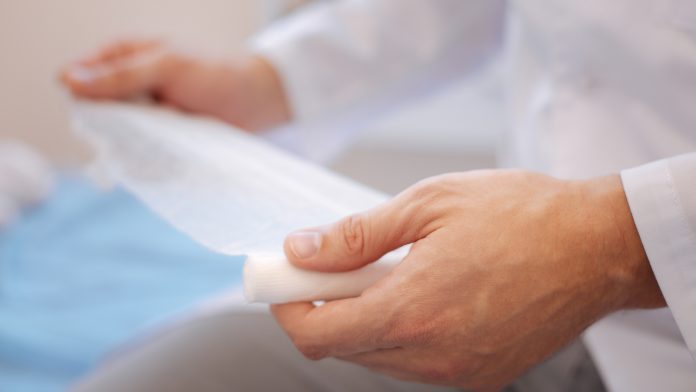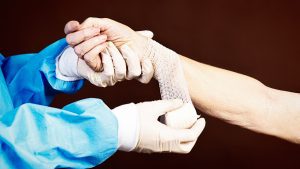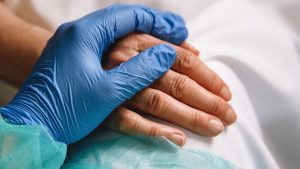
Dr Shahin Homaeigohar speaks to Health Europa Quarterly (HEQ) about the wound healing potential of nanofibrous dressings.
The management and treatment of wounds has become increasingly problematic for global healthcare systems. The progression of antibiotic resistant bacteria as well as a heightened vulnerability to impaired wound healing for those whose immune response has been weakened by old age, chronic illnesses or comorbidities means finding solutions that can accelerate wound healing and prevent infection is becoming evermore challenging. This year the global market for wound care is estimated to be worth $20.4 billion and this figure is expected to rise in tandem with the growing number of people suffering from chronic diseases including diabetes and obesity. In a bid to accelerate the rate of healing and improve clinical outcomes for those suffering acute and chronic wounds, a new class of smart wound dressings is starting to emerge. One such technology is biopolymeric nanofibers. Unlike traditional wound dressings such as films, sponges, and foams, nanofibrous dressings can facilitate the delivery of antibacterial agents over a large surface area and can biomimic the skin’s extracellular matrix structure to further promote healing. To find out more, HEQ spoke to Dr Shahin Homaeigohar who is an Assistant Professor of Biomedical Engineering at the University of Dundee and a former Marie-Sklodowska Curie Postdoc Fellow looking into nanofibrous wound dressings as part of an EU-funded SNFWD project.
What are some of the significant challenges facing the management and treatment of wounds today?
Firstly, if we look at acute wounds, which are formed quite suddenly perhaps through surgery or trauma, as soon as these occur, the body starts to heal itself. This natural biological process has several healing stages from haemostasis through to inflammation and subsequently the proliferation of cells and tissue remodelling. However, sometimes there can be abnormalities in the healing stage and this could eventually lead to chronic wounds.
There are many factors that can instigate chronic wounds including the presence of existing diseases which affect blood circulation and the immune system’s response. Metabolic disorders such as diabetes, the consumption of particular medications or even radiation therapy can also lead to the development of chronic wounds. These types of wounds are characterised by prolonged or excessive inflammation which can be difficult to treat. One solution is the use of antibiotics but here we come across the challenge of antimicrobial resistance (AMR) which is an increasing problem in the treatment of infections. As well as inflammation, infection and AMR, poor performance of dermal and epidermal cells that cannot readily respond to different stimuli can also thwart the healing process.
Are any groups particularly at risk of more severe or difficult-to-treat wounds?
Age is an important factor but there are also some patients who are particularly vulnerable to chronic wounds. Those with blood circulatory issues can be particularly affected and likewise, people who are taking certain medication or are suffering with cancer and exposed to chemotherapy or radiation therapy can also be at risk. People with vascular diseases and arterial diseases or those who have been hospitalised for a long time and are exposed to prolonged pressure, or neuropathy could also suffer from chronic wounds.
What can be done to minimise the risk of infection when treating difficult wounds?
With regards to infection, there are some conventional approaches such as antibiotic ointments like cleansing agents for example, but these are not that efficient these days due to AMR. The other approach that could be taken in respect to infection is using wound dressing materials that contain some kind of antibiotic and antibacterial agents including penicillin, or methicillin. There are other kinds of antibacterial agents including quaternary ammonium compounds, metallic ions, and nanoparticles, especially silver which is very popular in infection prevention. Some types of polymers are also shown to have antimicrobial properties. These polymers can contain naturally derived ingredients and when combined with other antibacterial agents, such as silver, can achieve much better antibacterial performance.
One very new class of materials that are under research are antimicrobial peptides (AMPs). These bio-derived antibiotics are derived from different creatures such as mammals, fish, insects, and amphibians. Natural antibacterial sources such as medical grade Manuka honey also show very optimal antimicrobial performance and so wound dressings can contain these properties to promote healing by releasing peroxide and non-peroxide antibacterial agents.

Following the EU-funded SNFWD project, can you explain how nanofibrous wound dressings work and encourage wound healing?
There is a rationale behind the use of nanofibrous wound dressings because their structure mimics our body’s native tissue structure. We have a collagenic nanofibrous matrix, or extracellular matrix, within our natural tissues so if we are able to mimic this structure using bio-compatible polymers, then these cells can interact in a better way with these nano structures. Further to this biomimicry, the nanofibrous wound dressings can also cover a much greater surface area compared to conventional wound dressings and can also be loaded with antibacterial agents. For example, we can deposit antibacterial agents such as singular nanoparticles or antibiotics. These agents would be loaded onto the surface of the wound dressing and released gradually into the wound over the course of the healing process and could also lead to vascularization within the wound.
Aside from antibacterial agents, we can also add wound-healing promoters which can be released into the wound very efficiently. This nanofibrous wound dressing system is therefore able to cover several aspects of wound healing which could greatly benefit the treatment of chronic wounds which can be incredibly lengthy and unpleasant for the patient. In short, we have a wound dressing system that bio-mimics, can release antibacterial agents and pro angiogenesis factors and as a result promote vascularization within the wound.

Nanofibrous wound dressings have several advantages over the benchmark for wound dressings which are very important for healing.
What advantages do nanofibrous dressings offer over conventional wound dressings?
There are several things we need to look at if we want to compare nanofibrous wound dressings with the golden benchmark for wound dressings which include films, foams, microfibers, and mesh. Firstly, nanofibrous dressings are highly porous which allows for efficient permeability of water vapour and oxygen. They also contain nanoscale fibers that can confer the small interstices and high surface area to accelerate hemostasis. Additionally, the material features very small pores so harmful bacteria, from the surrounding hospital environment for instance, cannot penetrate the wound. Nanofibrous wound dressings also provide excellent conformability compared to other commercial dressings, so this means the wounds have better coverage and, in turn, are better protected from infection. We have a very extensive surface area for these nanofibrous wound dressings, and this enables us to load or incorporate drugs, wound healing promoters, pro angiogenesis factors and such onto the dressing and as a result control the release of these beneficial agents. All of these advantages are very promising and therefore we want to promote the adoption of this new class of wound dressing.
What more could be done at policy and procurement levels to encourage the widespread adoption of novel wound dressings?
If you have a look at the wound care market, you cannot find any commercial nanofibrous wound dressing materials. One reason for this is that there were some doubts regarding scalability of production because the main technique that is used to produce nanofibers is electrospinning. Electrospinning was known as a technique that was limited to one single nozzle and very low production rates, but the technique has really advanced over the last few years. Now, instead of using one single nozzle, we have nozzleless, or needleless electrospinning apparatus. These new technologies and processes have been very promising and have made the researchers and even industrial stakeholders more optimistic about the prospect of electrospinning, and now we are able to produce nanofibers at a very large scale. We can produce nanofibrous mass of several square metres, for example, and this is very encouraging.
We want to change the mindsets of the people who design these policies, but this also means that we need further financial investments for the new ideas that support scalable production of nanofibers. Furthermore, we should not be limited to engineering, we should also be looking at this material from a clinical perspective. There needs to be greater flexibility from clinical leadership with regards to pre-clinical and clinical tests. These kinds of new technologies are mainly followed by researchers who are at the beginning of their careers because established researchers are perhaps not so optimistic about this type of novel research. We need to support researchers through flexible funding programmes to enable them to realise the potential of these new ideas. If we do, we could establish start-up or spin-off companies that can specifically work on such novel wound dressings.
There is also a missing link between industrial research and academia. What is developed in a lab does not necessarily reach the industry. It is important that researchers keep in contact with clinicians and share information about these new technologies and their benefits as these could greatly alleviate the burden posed by chronic wounds for both patients and healthcare systems.
Dr Shahin Homaeigohar
Assistant Professor of Biomedical Engineering & Baxter Fellow
University of Dundee
www.dundee.ac.uk
This article is from issue 18 of Health Europa. Click here to get your free subscription today.










